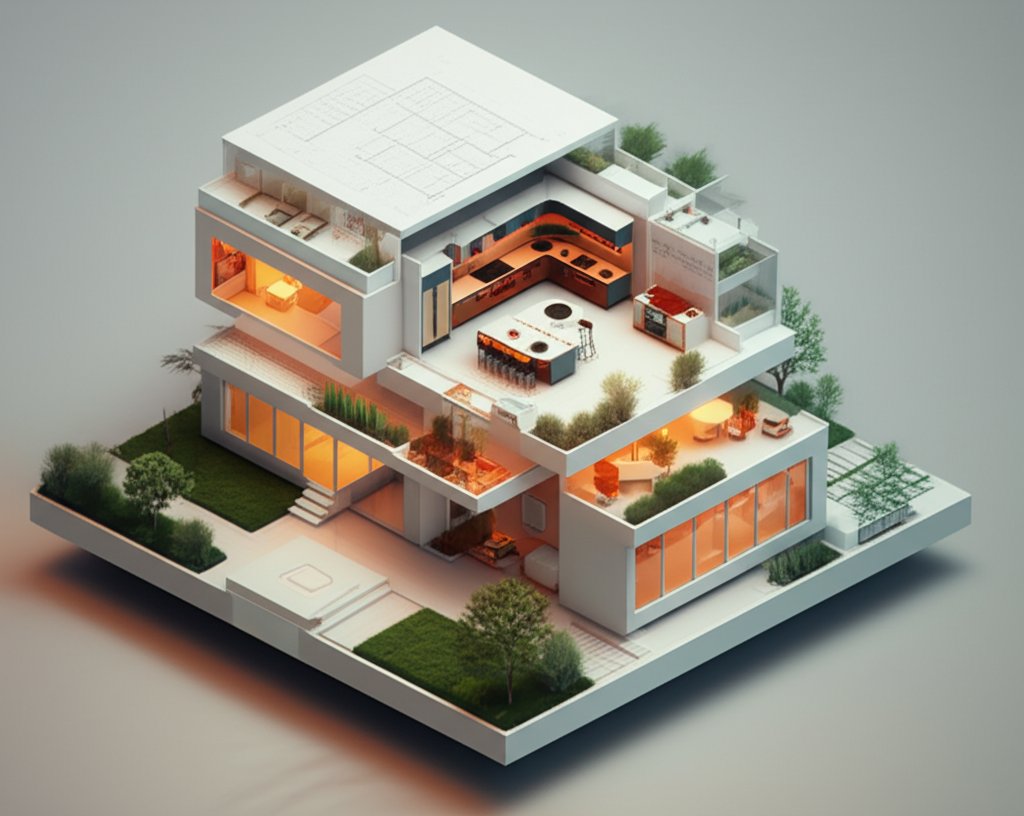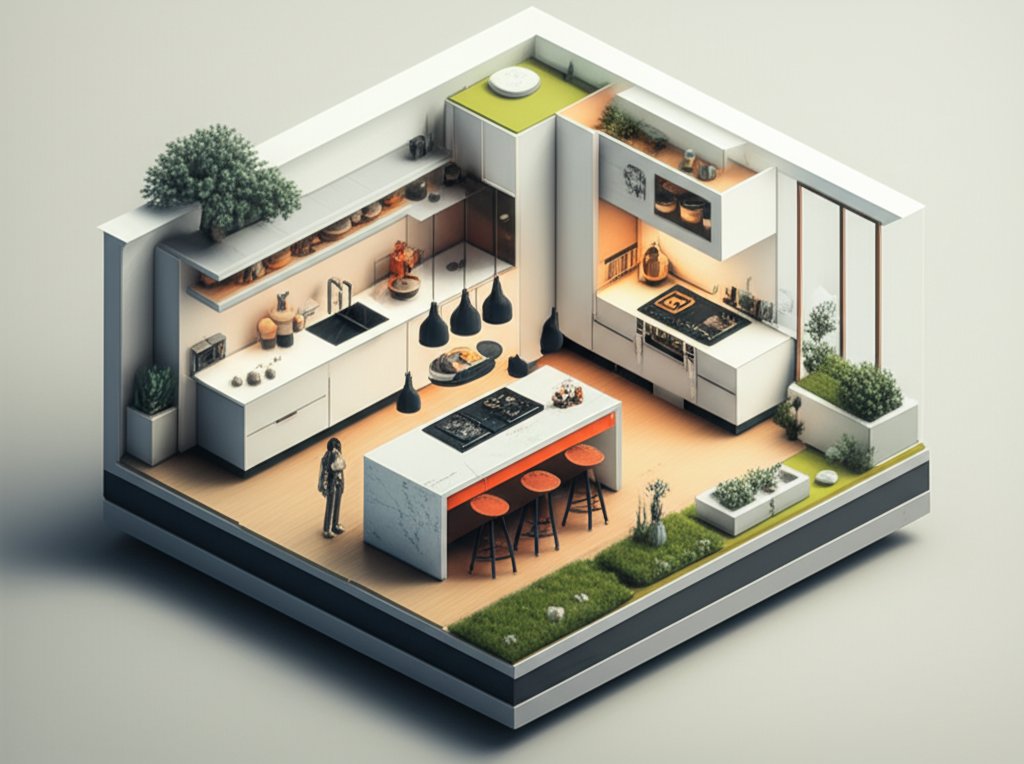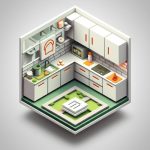Imagine a kitchen where you can effortlessly prep meals, gather with loved ones, and showcase your personal style – all centered around a stunning island that’s as practical as it is beautiful. That’s the promise of thoughtful big island kitchen design. But pulling it off requires more than just a large countertop.
This guide will walk you through the key considerations, design principles, and creative ideas to transform your kitchen into the heart of your home with a captivating and functional big island.
At a glance:
- Size Matters: Measure your space carefully to ensure comfortable walkways around your island.
- Functionality First: Prioritize how you’ll use the island (prep, cooking, seating, storage) to guide your design choices.
- Style Harmony: Choose materials and finishes that complement your existing kitchen décor.
- Think Beyond the Countertop: Consider adding storage, appliances, and seating to maximize your island’s utility.
- Lighting is Key: Incorporate task and ambient lighting to create a welcoming and functional workspace.
The Allure of the Big Island: More Than Just Counter Space
A big kitchen island offers so much more than just extra surface area. It’s a central hub, a gathering place, and a statement piece all rolled into one.
- It provides extra counter space, more storage, and an opportunity for the family to get together and talk while cooking.
- Aside from all its practical uses, the island can also serve as a decorative focal point of the room.
- Islands come in all shapes in sizes, whether you want an extra workspace you can move around on wheels or you want a large island with a breakfast bar
Planning Your Big Island: First Considerations
Before you finalize any design choices, it’s crucial to consider these fundamental aspects:
Evaluating Your Kitchen Layout and Size
A spacious island requires a spacious kitchen. Cramming a large island into a small space will make your kitchen feel cramped and dysfunctional.
- Measure Carefully: Accurately measure your kitchen’s dimensions, including the space between counters, appliances, and walkways.
- Minimum Clearances: Aim for at least 42 inches of clearance between the island and surrounding countertops and appliances. 48 inches is even better for busy kitchens or those with multiple cooks.
- Island Size Relative to Kitchen Size: Larger kitchens can most likely accommodate a big kitchen island. Smaller kitchens do not usually have the space for a large island and will look funny if you don’t allow for enough space to walk around all the sides of the island. Also consider the length This is critical.
Defining Your Island’s Primary Function
What will your island be used for primarily? Answering this will drive your design choices.
- Food Preparation: If you’re a passionate cook, prioritize ample counter space, a prep sink, and easy access to cooking appliances.
- Casual Dining: Breakfast bars and seating areas are perfect for informal meals and quick snacks.
- Storage: Maximize storage with cabinets, drawers, shelves, and even specialized storage solutions like pull-out spice racks or wine storage.
- Gathering and Entertaining: Consider an extended countertop for seating, a built-in beverage fridge, and space for appetizers and drinks.
Understanding the Kitchen Work Triangle
The work triangle connects the three main work areas: the sink, the stove and the refrigerator. The distance between these areas should be no less than 4 feet and no larger than 9 feet. The sum of all three sides of the triangle should be between 13 feet and 26 feet.
If you cook a lot, place the island adjacent to the stove and prep areas to make cooking more efficient.Placing it near a sink will give you easy access to water, which will also help with cooking. However, if you have an open-plan layout, you can place the island between rooms to act as a divider while still keeping a nice flow through the house.
Big Island Design Ideas: Functionality Meets Style
Now, let’s dive into some specific design ideas that blend functionality with aesthetic appeal.
Countertop Materials: Choosing the Right Surface
Your countertop is the island’s focal point, so choose a material that’s durable, beautiful, and fits your budget.
- Granite: A classic choice known for its durability, heat resistance, and unique patterns.
- Quartz: Engineered stone that’s non-porous, stain-resistant, and available in a wide range of colors and patterns.
- Marble: A luxurious option with a timeless elegance, but requires more maintenance due to its porous nature.
*Stone countertops like marble, granite and quartz are well worth the money for something that will have a significant amount of longevity and durability. - Wood: Adds warmth and character, especially for farmhouse or cottage-style kitchens.
*Wood countertops might be more of your style if you like a cottage and farmhouse style. - Concrete: A modern and industrial option that’s durable and can be customized with colors and textures.
*Concrete is ideal if you love a modern and contemporary approach that is low maintenance.
Incorporating Sinks and Appliances
Adding a sink or appliance to your island can significantly boost its functionality.
- Prep Sink: Ideal for food preparation, washing vegetables, and quick cleanups. Consider a second smaller sink if you have the room!
- Cooktop: A cooktop on the island allows you to face your guests while cooking. Ensure proper ventilation with a downdraft vent or overhead range hood.
- Dishwasher: Integrating a dishwasher into the island streamlines cleanup and keeps dirty dishes out of sight.
- Beverage Fridge: Perfect for storing drinks and keeping them easily accessible during gatherings.
- Microwave Drawer: A space-saving option that frees up countertop space.
Storage Solutions: Maximizing Every Inch
A big island offers a wealth of storage opportunities. Here are some ideas to consider:
- Drawers: Perfect for storing pots, pans, utensils, and other kitchen essentials.
- Cabinets: Use cabinets to store larger items like appliances, serving dishes, and pantry staples.
- Open Shelving: Add open shelving to display cookbooks, decorative items, or frequently used items.
- Pull-Out Shelves: Maximize access to items stored in deep cabinets.
- Wine Rack: Integrate a wine rack for storing and displaying your favorite wines.
Seating Arrangements: Creating a Gathering Space
Seating is a key element of most kitchen islands.
- Breakfast Bar: A raised countertop with bar stools is a classic option for casual dining.
- Counter-Height Seating: A single-level countertop with counter-height stools creates a more unified and modern look.
- Overhang: Ensure adequate overhang (at least 12 inches) for comfortable knee space.
- Seating Capacity: Consider how many people you want to seat at your island regularly.
Lighting: Illuminating Your Island’s Beauty and Function
Proper lighting is essential for both task and ambiance.
- Pendant Lights: Hang pendant lights above the island to provide task lighting and add a stylish focal point.
- Recessed Lighting: Use recessed lighting to provide general illumination.
- Under-Cabinet Lighting: Add under-cabinet lighting to illuminate countertops and make food preparation easier.
- Dimmable Lighting: Install dimmers to adjust the lighting to suit different moods and activities.
Design Styles: Finding Your Perfect Match

Your island should complement your overall kitchen design style.
- Modern: Clean lines, minimalist design, and sleek materials like stainless steel and quartz.
- Traditional: Classic details, ornate cabinetry, and warm colors.
- Farmhouse: Rustic charm, natural materials like wood and stone, and vintage-inspired accents.
- Industrial: Exposed brick, concrete countertops, and metal accents.
- Coastal: Light and airy colors, natural textures like wood and rattan, and nautical-inspired décor.
DIY vs. Professional Installation: Making the Right Choice
If you have woodworking skills and the time, building a kitchen island might be a better option. You can customize the size and features to get exactly what you want and need. However, it requires a higher skill level than a lot of other household projects. Meanwhile, buying an island is more convenient, the pricing is more straightforward, and you can find budget-friendly options.
Common Questions About Big Island Kitchen Design
Here are some frequently asked questions and their answers:
How big should my kitchen island be?
The ideal size depends on your kitchen’s dimensions and your needs. As a starting point, remember to maintain a minimum of 42 inches of clearance around all sides of the island. Dreaming of a bigger island? Just make sure you don’t sacrifice functionality.
What is the best countertop material for a kitchen island?
Granite, quartz, and wood are all popular choices, each with its own pros and cons based on maintenance, aesthetics, and budget.
How much overhang should I have for seating at my island?
At least 12 inches is recommended for comfortable knee space.
Should I put a sink or cooktop in my island?
This depends on how you plan to use the island. A prep sink is great for food preparation, while a cooktop allows you to face your guests while cooking.
How can I maximize storage in my kitchen island?
Use a combination of drawers, cabinets, open shelving, and pull-out shelves to maximize storage space.
Making Your Big Island Dreams a Reality
Designing the perfect big island kitchen requires careful planning and consideration. By defining your needs, evaluating your space, and exploring the design ideas outlined above, you can create a functional and stylish kitchen that will be the heart of your home for years to come. Think about the ways you plan to use the island. I wanted our central island to have many uses in our kitchen area. Here are some of the most prominent ways we access it. Breakfast bar – Informal eating areas are a big perk with families. It’s a great way to use the counter space for an additional dining area that is more casual. Extra seating area – I bought bar stools to sit at the breakfast bar. It’s also very useful to be able to accommodate a few more friends around meal time. Kitchen sink placement – I opted to put my sink in the center of the kitchen island instead of on the opposite counter. This is the perfect place because it is central to my food prep area. Work space for homework and projects – Even though my kids have desk areas in their bedrooms, they like to be where everyone is. We have done homework at our island more times than I can count. Food preparation area – This is the main area for our prep space since it is so big
Instead of simply jumping into design, start by listing your needs and desires, and let that guide your choices. Then, enjoy the process of transforming your kitchen into the ultimate gathering place.
- Glass On Tile: A Stylish Kitchen Backsplash Option - December 1, 2025
- Glass Tiles for Kitchen: Style and Durability Tips - November 30, 2025
- Decorative Wall Tiles for Kitchen: Stylish Design Ideas - November 29, 2025










